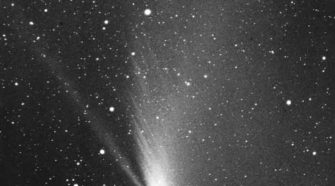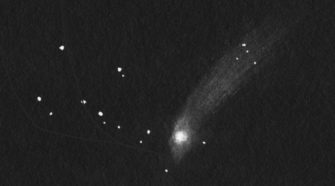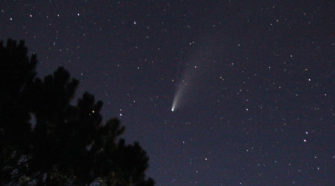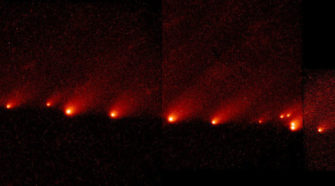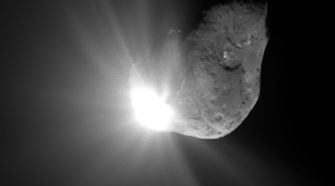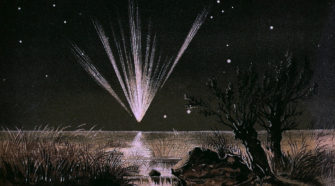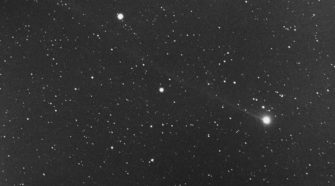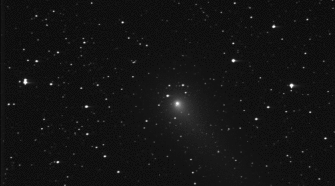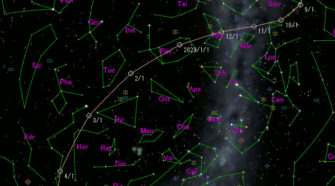Comet
Comet of the Week: Mrkos 1957d
Perihelion: 1957 August 1.44, q = 0.355 AU During the mid-20th Century the northern hemisphere went several decades without a bright naked-eye comet; what bright comets that did appear during that time were primarily visible from the southern hemisphere. This changed during 1957, when Comet Arend-Roland 1956h became bright and conspicuous during April and May, …
Comet of the Week: 67P/Churyomov-Gerasimenko
Perihelion: 2015 August 13.08, q = 1.243 AU There have been a handful of occasions throughout recent history when someone has discovered a comet while looking for, or examining, another one. Such an incident happened in late 1969 in the former Soviet Union, when on September 11 Svetlana Gerasimenko with the Alma Ata Observatory (in …
Comet of the Week: NEOWISE C/2020 F3
Perihelion: 2020 July 3.68, q = 0.295 AU For the second time during the course of “Ice and Stone 2020” I have found it appropriate to swap out my originally intended “Comet of the Week” for a comet currently appearing in our skies. For the past three weeks, Comet NEOWISE has been putting on a …
Comet of the Week: Hale-Bopp C/1995 O1
Perihelion: 1997 April 1.14, q = 0.914 AU This week’s “Special Topics” presentation discusses, among other things, how the practice of discovering comets has changed over the years. Up until a couple of decades ago a rather large percentage of the known comets were discovered by amateur astronomers regularly scanning the skies with relatively small …
Comet of the Week: Shoemaker-Levy 9 1993e
Perihelion: 1994 April 18.57, q = 5.380 AU What could perhaps be considered the most successful search program for comets and near-Earth asteroids during the photographic era, i.e., before the advent of CCD-based comprehensive survey programs in the late 1990s, was conducted by renowned planetary geologist Eugene Shoemaker from 1982 to 1994. Usually once a …
Comet of the Week: 9P/Tempel 1
Perihelion: 2005 July 05.31, q = 1.506 AU With the various comprehensive survey programs that are currently operational, the discovery of previously-unknown short-period comets happens all the time these days. The situation was very different during the mid-19th Century, when only a handful of such objects were known, and the discovery of each one was …
Comet of the Week: Tebbutt 1861 II
Perihelion: 1861 June 12.01, q = 0.822 AU Two of the brighter comets of the latter half of the 19th Century were discovered by an Australian amateur astronomer, John Tebbutt, who for four decades essentially ran a one-man astronomical clearinghouse from his private observatory near Windsor, New South Wales. In addition to numerous astrometric observations …
Comet of the Week: 2P/Encke
Perihelion: 2020 June 25.85, q = 0.337 AU In the early 19th Century the idea that comets might return to the inner solar system on a regular basis was still a bit of a novelty. This had been successfully demonstrated by the British astronomer Edmond Halley when the comet that now bears his name returned …
Comet of the Week: LINEAR C/2001 A2
Perihelion: 2001 May 24.52, q = 0.779 AU At the beginning of the 21st Century the discovery of comets and near-Earth asteroids was dominated by the first of the comprehensive sky surveys, the LIncoln Near-Earth Asteroid Research (LINEAR) program run by MIT’s Lincoln Laboratory and based at White Sands Missile Range in New Mexico, that …
Comet of the Week: PANSTARRS C/2017 K2
Perihelion: 2022 December 19.67, q = 1.797 AU I’ve hinted in some of the earlier presentations of “Ice and Stone 2020” that, for the past few years, we have been in a slow period when it comes to bright comets. Indeed, for “Great Comets” – discussed in a previous “Special Topics” presentation – the most …

